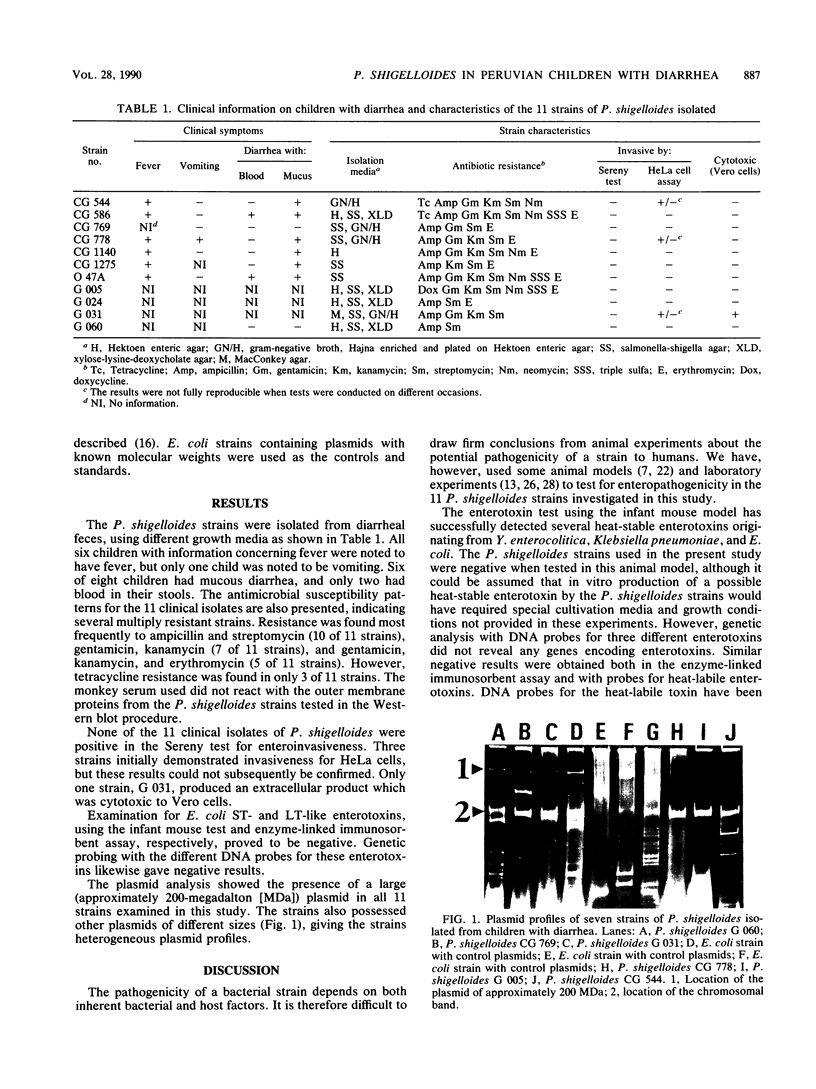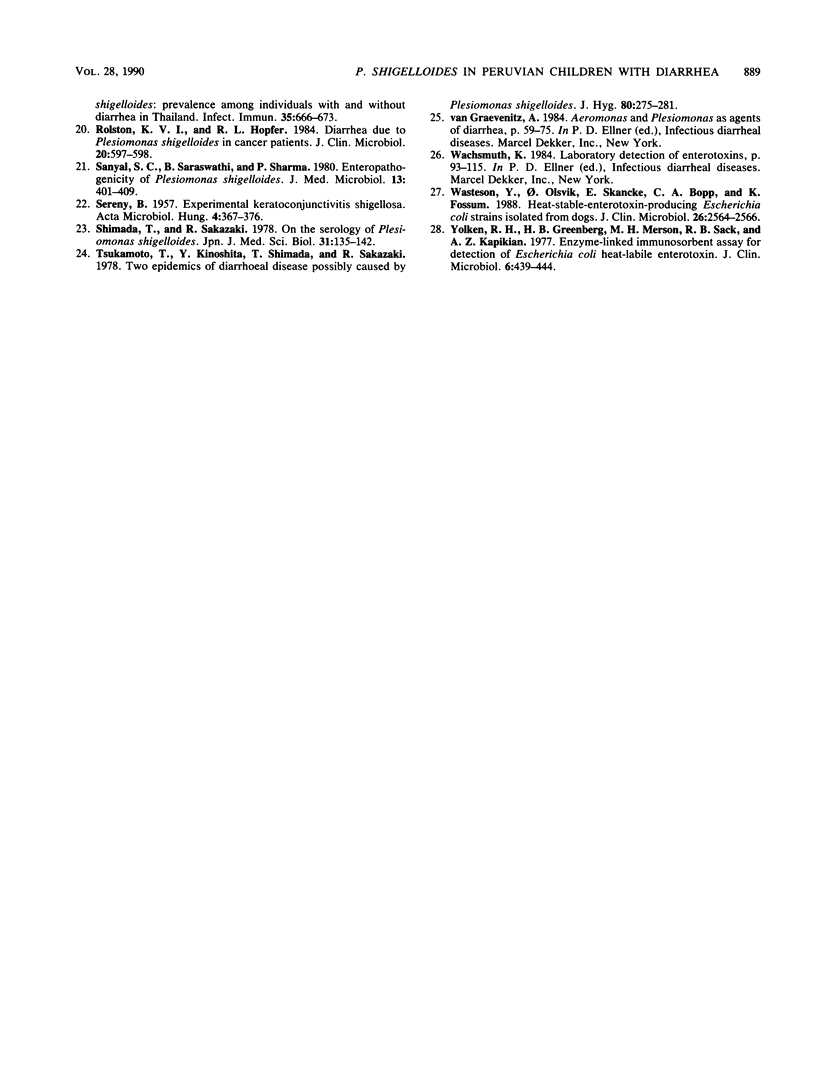Abstract
Eleven strains of Plesiomonas shigelloides isolated from 10 Peruvian children with diarrhea were examined. All the strains were resistant to two or more antibiotics, most commonly ampicillin, gentamicin, erythromycin, kanamycin, and streptomycin. The strains were all negative in the Sereny and cell culture assays used to test for enteroinvasiveness. One strain showed cytotoxic activity on Vero cells. The strains showed no antigenic relationship with Shigella organisms. Both bioassays and enzyme-linked immunosorbent assays used for detection of Escherichia coli enterotoxins were negative. Nucleic acid probes for such toxins likewise gave negative results. The strains all possessed a large (approximately 200-megadalton) plasmid in addition to one or more other plasmids. Several different plasmid profiles were observed among these 11 P. shigelloides strains, indicating that the isolates were not acquired from a common source or from a single bacterial clone.
Full text
PDF



Images in this article
Selected References
These references are in PubMed. This may not be the complete list of references from this article.
- Arai T., Ikejima N., Itoh T., Sakai S., Shimada T., Sakazaki R. A survey of Plesiomonas shigelloides from aquatic environments, domestic animals, pets and humans. J Hyg (Lond) 1980 Apr;84(2):203–211. doi: 10.1017/s002217240002670x. [DOI] [PMC free article] [PubMed] [Google Scholar]
- Binns M. M., Vaughan S., Sanyal S. C., Timmis K. N. Invasive ability of Plesiomonas shigelloides. Zentralbl Bakteriol Mikrobiol Hyg A. 1984 Aug;257(3):343–347. [PubMed] [Google Scholar]
- Birnboim H. C., Doly J. A rapid alkaline extraction procedure for screening recombinant plasmid DNA. Nucleic Acids Res. 1979 Nov 24;7(6):1513–1523. doi: 10.1093/nar/7.6.1513. [DOI] [PMC free article] [PubMed] [Google Scholar]
- Böttger E. C., Jürs M., Barrett T., Wachsmuth K., Metzger S., Bitter-Suermann D. Qualitative and quantitative determination of enterobacterial common antigen (ECA) with monoclonal antibodies: expression of ECA by two Actinobacillus species. J Clin Microbiol. 1987 Feb;25(2):377–382. doi: 10.1128/jcm.25.2.377-382.1987. [DOI] [PMC free article] [PubMed] [Google Scholar]
- Dahm L. J., Weinberg A. G. Plesiomonas (Aeromonas) shigelloides septicemia and meningitis in a neonate. South Med J. 1980 Mar;73(3):393–394. doi: 10.1097/00007611-198003000-00039. [DOI] [PubMed] [Google Scholar]
- Dean A. G., Ching Y. C., Williams R. G., Harden L. B. Test for Escherichia coli enterotoxin using infant mice: application in a study of diarrhea in children in Honolulu. J Infect Dis. 1972 Apr;125(4):407–411. doi: 10.1093/infdis/125.4.407. [DOI] [PubMed] [Google Scholar]
- Fischer K., Chakraborty T., Hof H., Kirchner T., Wamsler O. Pseudoappendicitis caused by Plesiomonas shigelloides. J Clin Microbiol. 1988 Dec;26(12):2675–2677. doi: 10.1128/jcm.26.12.2675-2677.1988. [DOI] [PMC free article] [PubMed] [Google Scholar]
- Gardner S. E., Fowlston S. E., George W. L. In vitro production of cholera toxin-like activity by Plesiomonas shigelloides. J Infect Dis. 1987 Nov;156(5):720–722. doi: 10.1093/infdis/156.5.720. [DOI] [PubMed] [Google Scholar]
- Hale T. L., Sansonetti P. J., Schad P. A., Austin S., Formal S. B. Characterization of virulence plasmids and plasmid-associated outer membrane proteins in Shigella flexneri, Shigella sonnei, and Escherichia coli. Infect Immun. 1983 Apr;40(1):340–350. doi: 10.1128/iai.40.1.340-350.1983. [DOI] [PMC free article] [PubMed] [Google Scholar]
- Holmberg S. D., Farmer J. J., 3rd Aeromonas hydrophila and Plesiomonas shigelloides as causes of intestinal infections. Rev Infect Dis. 1984 Sep-Oct;6(5):633–639. doi: 10.1093/clinids/6.5.633. [DOI] [PubMed] [Google Scholar]
- Holmberg S. D., Wachsmuth I. K., Hickman-Brenner F. W., Blake P. A., Farmer J. J., 3rd Plesiomonas enteric infections in the United States. Ann Intern Med. 1986 Nov;105(5):690–694. doi: 10.7326/0003-4819-105-5-690. [DOI] [PubMed] [Google Scholar]
- Konowalchuk J., Speirs J. I., Stavric S. Vero response to a cytotoxin of Escherichia coli. Infect Immun. 1977 Dec;18(3):775–779. doi: 10.1128/iai.18.3.775-779.1977. [DOI] [PMC free article] [PubMed] [Google Scholar]
- Lim P. L. Some interesting isolates from a diagnostic laboratory. J Clin Pathol. 1978 Mar;31(3):223–226. doi: 10.1136/jcp.31.3.223. [DOI] [PMC free article] [PubMed] [Google Scholar]
- Mehlman I. J., Eide E. L., Sanders A. C., Fishbein M., Aulisio C. C. Methodology for recognition of invasive potential of Escherichia coli. J Assoc Off Anal Chem. 1977 May;60(3):546–562. [PubMed] [Google Scholar]
- Meyers J. A., Sanchez D., Elwell L. P., Falkow S. Simple agarose gel electrophoretic method for the identification and characterization of plasmid deoxyribonucleic acid. J Bacteriol. 1976 Sep;127(3):1529–1537. doi: 10.1128/jb.127.3.1529-1537.1976. [DOI] [PMC free article] [PubMed] [Google Scholar]
- Nolte F. S., Poole R. M., Murphy G. W., Clark C., Panner B. J. Proctitis and fatal septicemia caused by Plesiomonas shigelloides in a bisexual man. J Clin Microbiol. 1988 Feb;26(2):388–391. doi: 10.1128/jcm.26.2.388-391.1988. [DOI] [PMC free article] [PubMed] [Google Scholar]
- Olsvik O., Wachsmuth K., Morris G., Feeley J. C. Genetic probing of Campylobacter jejuni for cholera toxin and Escherichia coli heat-labile enterotoxin. Lancet. 1984 Feb 25;1(8374):449–449. doi: 10.1016/s0140-6736(84)91773-2. [DOI] [PubMed] [Google Scholar]
- Pitarangsi C., Echeverria P., Whitmire R., Tirapat C., Formal S., Dammin G. J., Tingtalapong M. Enteropathogenicity of Aeromonas hydrophila and Plesiomonas shigelloides: prevalence among individuals with and without diarrhea in Thailand. Infect Immun. 1982 Feb;35(2):666–673. doi: 10.1128/iai.35.2.666-673.1982. [DOI] [PMC free article] [PubMed] [Google Scholar]
- Rolston K. V., Hopfer R. L. Diarrhea due to Plesiomonas shigelloides in cancer patients. J Clin Microbiol. 1984 Sep;20(3):597–598. doi: 10.1128/jcm.20.3.597-598.1984. [DOI] [PMC free article] [PubMed] [Google Scholar]
- SERENY B. Experimental keratoconjunctivitis shigellosa. Acta Microbiol Acad Sci Hung. 1957;4(4):367–376. [PubMed] [Google Scholar]
- Sanyal S. C., Saraswathi B., Sharma P. Enteropathogenicity of Plesiomonas shigelloides. J Med Microbiol. 1980 Aug;13(3):401–409. doi: 10.1099/00222615-13-3-401. [DOI] [PubMed] [Google Scholar]
- Shimada T., Sakazaki R. On the serology of Plesiomonas shigelloides. Jpn J Med Sci Biol. 1978 Apr;31(2):135–142. doi: 10.7883/yoken1952.31.135. [DOI] [PubMed] [Google Scholar]
- Tsukamoto T., Kinoshita Y., Shimada T., Sakazaki R. Two epidemics of diarrhoeal disease possibly caused by Plesiomonas shigelloides. J Hyg (Lond) 1978 Apr;80(2):275–280. doi: 10.1017/s0022172400053638. [DOI] [PMC free article] [PubMed] [Google Scholar]
- Wasteson Y., Olsvik O., Skancke E., Bopp C. A., Fossum K. Heat-stable-enterotoxin-producing Escherichia coli strains isolated from dogs. J Clin Microbiol. 1988 Dec;26(12):2564–2566. doi: 10.1128/jcm.26.12.2564-2566.1988. [DOI] [PMC free article] [PubMed] [Google Scholar]
- Yolken R. H., Greenberg H. B., Merson M. H., Sack R. B., Kapikian A. Z. Enzyme-linked immunosorbent assay for detection of Escherichia coli heat-labile enterotoxin. J Clin Microbiol. 1977 Nov;6(5):439–444. doi: 10.1128/jcm.6.5.439-444.1977. [DOI] [PMC free article] [PubMed] [Google Scholar]



